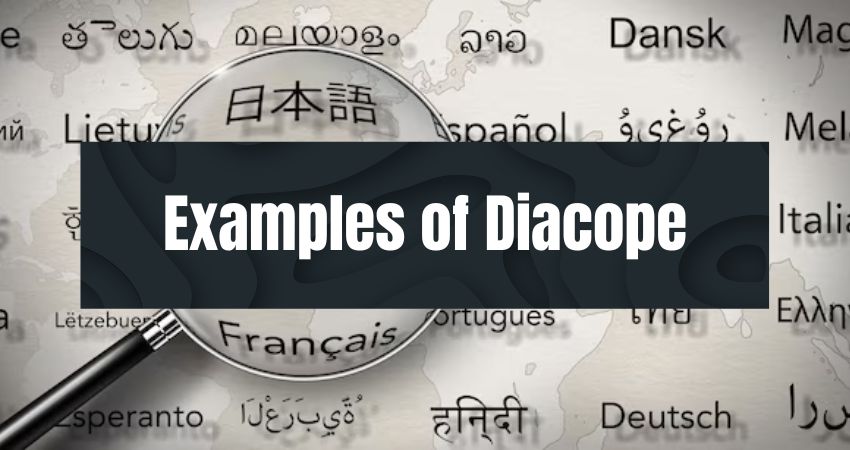Diacope, a powerful rhetorical device, involves the repetition of a word or phrase with a small number of intervening words. This age-old technique has found its place in various forms of communication, from literature and poetry to everyday language and social media. In this blog, we embark on a journey through the diverse angles of diacope, uncovering 50 examples that showcase its versatility and impact.
Art of Diacope: Examples from Various Angles
Different examples of Diacope from various angles are given below;
Classic Examples of Diacope
- “To be or not to be.” – Hamlet by William Shakespeare
- “Bond. James Bond.” – James Bond film series
- “I have a dream.” – Martin Luther King Jr.’s famous speech
In these classic examples, diacope is used for emphasis, turning simple phrases into memorable expressions that resonate through time.
Diacope in Everyday Language
- “Easy come, easy go.”
- “Time after time.”
- “Love me or leave me.”
Diacope is not confined to the realms of literature; it permeates our everyday language, adding rhythm and emphasis to common expressions.
Diacope in Advertising
- “Have a break, have a Kit Kat.”
- “Just do it.” – Nike
- “Snap, Crackle, Pop.” – Rice Krispies
Advertisers leverage diacope to create catchy slogans that stick in the minds of consumers, emphasizing the brand’s message.
Diacope in Poetry
- “Do not go gentle into that good night, Old age should burn and rave at close of day.” – Dylan Thomas
- “Tyger Tyger, burning bright, In the forests of the night.” – William Blake
- “A dream within a dream.” – Edgar Allan Poe
Poets use diacope to enhance the musicality of their verses, creating a rhythmic and emotional impact.
Diacope in Political Speeches
- “We shall fight on the beaches, we shall fight on the landing grounds, we shall fight in the fields and in the streets.” – Winston Churchill
- “Yes we can.” – Barack Obama
- “Ask not what your country can do for you, ask what you can do for your country.” – John F. Kennedy
Political figures employ diacope to make their messages memorable and stir emotions in their audiences.
Diacope in Song Lyrics
- “I want you, I need you, but there ain’t no way I’m ever gonna love you.” – Meat Loaf, “I’d Do Anything for Love (But I Won’t Do That)”
- “Every step you take, I’ll be watching you.” – The Police, “Every Breath You Take”
- “I’m not living if you’re not by my side.” – Mariah Carey, “Without You”
Songwriters use diacope to create lyrical refrains that resonate with listeners, emphasizing the emotional core of the music.
Diacope in Film Dialogue
- “I’m the king of the world! I’m the king of the world!” – Titanic
- “Here’s looking at you, kid.” – Casablanca
- “There’s no place like home. There’s no place like home.” – The Wizard of Oz
In film, diacope is employed to etch memorable lines into the audience’s memory, emphasizing pivotal moments.
Diacope in Social Media
- “Love it or hate it, but you can’t ignore it.”
- “Tweet, retweet, tweet.”
- “Post now or post later, just don’t forget to post.”
On social media, brevity and impact are key, and diacope proves to be an effective tool for emphasis in limited characters.
Diacope in Scientific Writing
- “Publish or perish.”
- “Study hard, study smart.”
- “Observe, analyze, conclude.”
Even in the realm of scientific writing, diacope is employed to underscore key principles and findings.
Diacope in Public Speaking
- “I have a message, I have a message that the youth can do it.” – Malala Yousafzai
- “I am prepared to die, I am prepared to die.” – Nelson Mandela
- “This nation, this generation, in this hour has man’s first chance to build a great society.” – Lyndon B. Johnson
Public speakers use diacope to make their messages resonate, driving home important points and capturing the audience’s attention.
Diacope Across Cultures
- “Per aspera ad astra (Through hardships to the stars).” – Latin Proverb
- “Veni, vidi, vici (I came, I saw, I conquered).” – Julius Caesar
- “Nichts wissen, nichts vergessen (Know nothing, forget nothing).” – German Proverb
Diacope is a universal linguistic tool, finding expression in various languages and cultures.
Modern Twists on Diacope
- “Shop, click, buy.”
- “Swipe left, swipe right, find love.”
- “Post, share, connect.”
In the digital age, diacope takes on new forms, adapting to the fast-paced nature of modern communication.
Diacope in Humor
- “To boldly go where no man has gone before… to the bathroom.”
- “Eat, sleep, procrastinate, repeat.”
- “Work hard, stay positive, lazy Saturday, lazy Sunday.”
Comedians use diacope to create punchlines and comedic timing, enhancing the humor in their routines.
In the vast landscape of language and expression, diacope stands as a timeless and versatile rhetorical device. From the pages of classic literature to the tweets of the digital era, its impact is undeniable. These 50 examples offer a glimpse into the myriad ways diacope enriches our communication, proving that repetition, when wielded with finesse, is a truly powerful tool in the hands of a wordsmith.
Whether in poetry, political speeches, or everyday conversation, diacope invites us to appreciate the artistry of language and the profound impact that a well-placed repetition can have on our understanding and interpretation of the world around us. So, the next time you encounter a repeated phrase, take a moment to appreciate the subtle brilliance of diacope at work.

